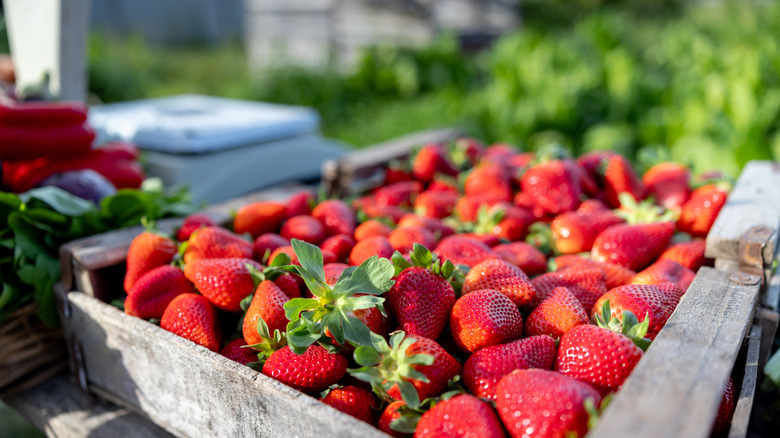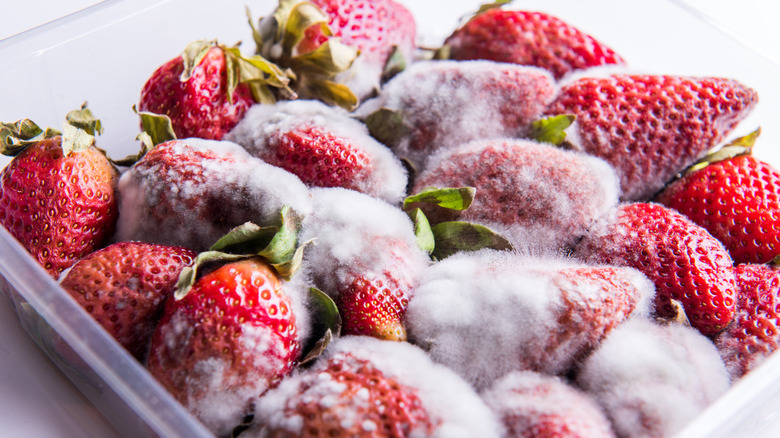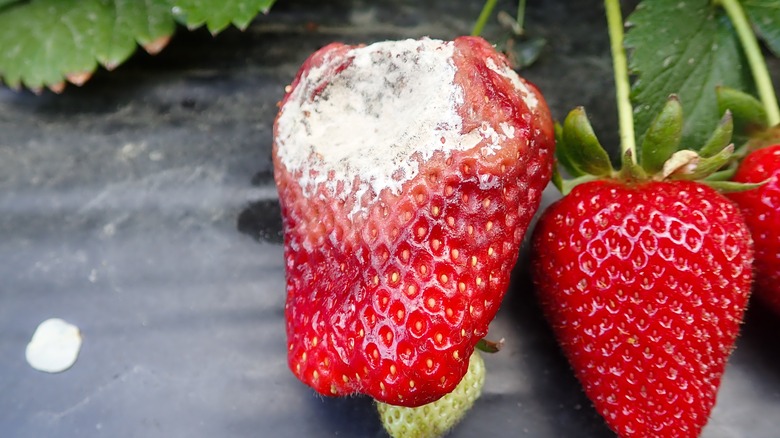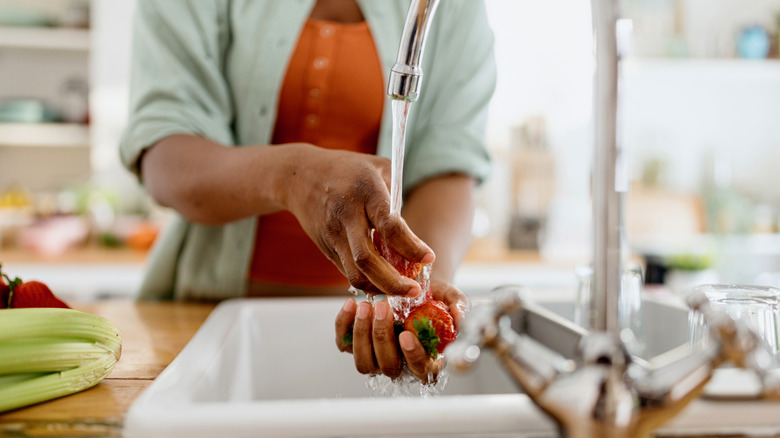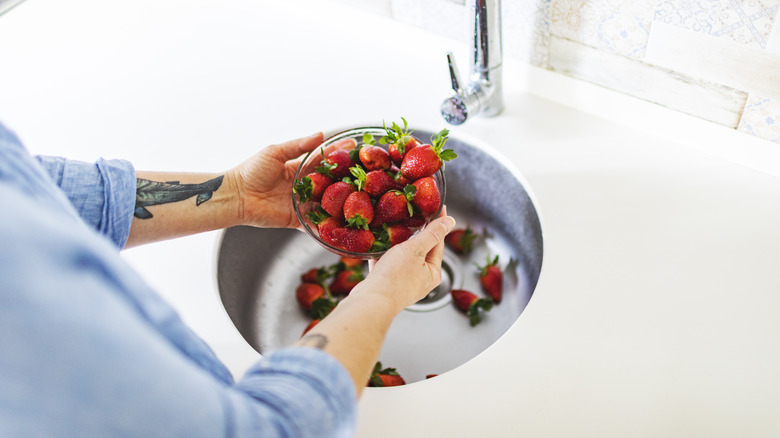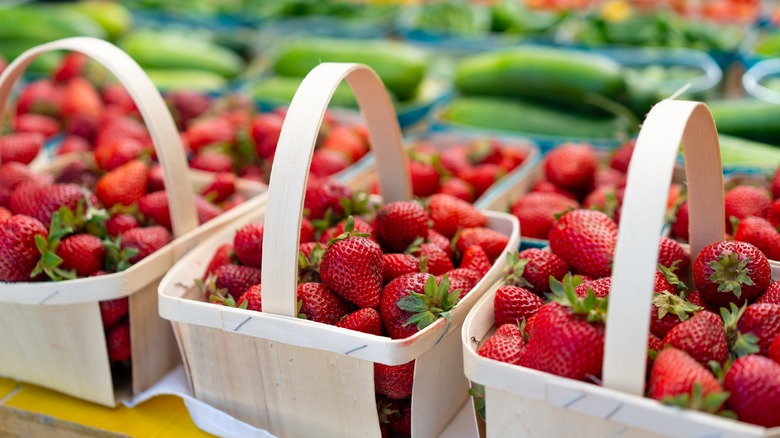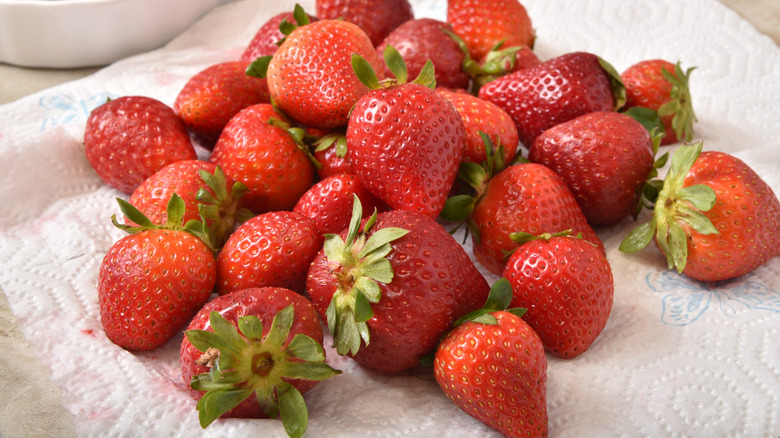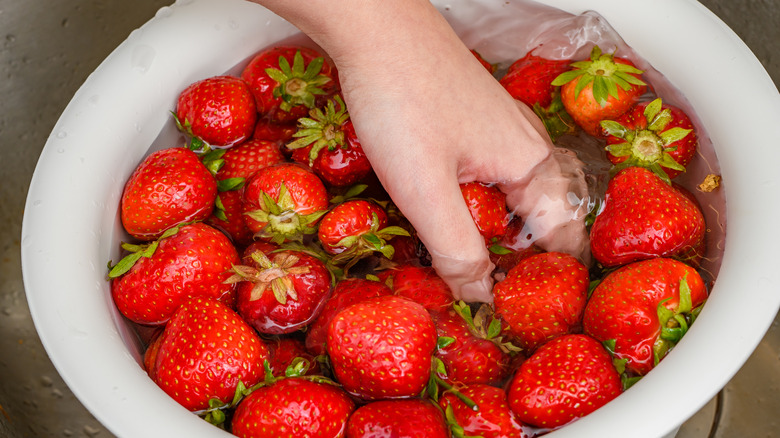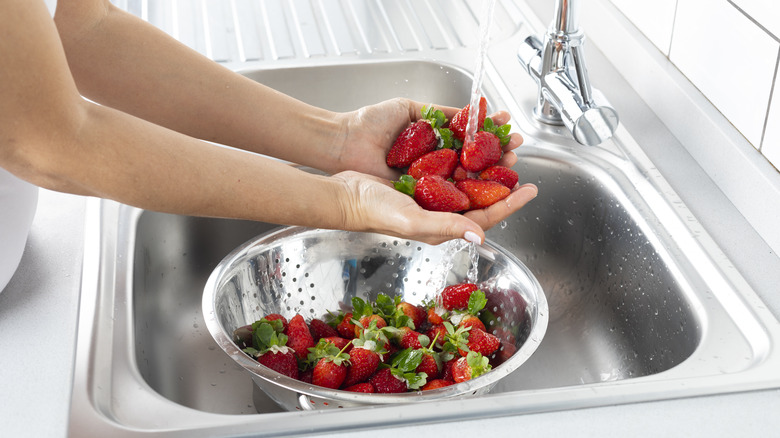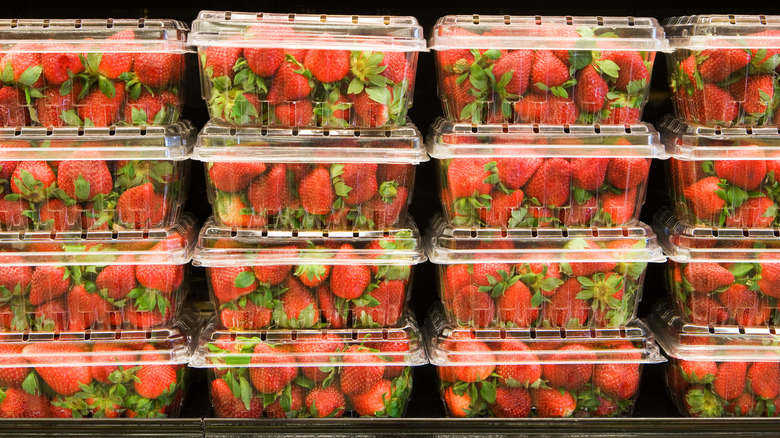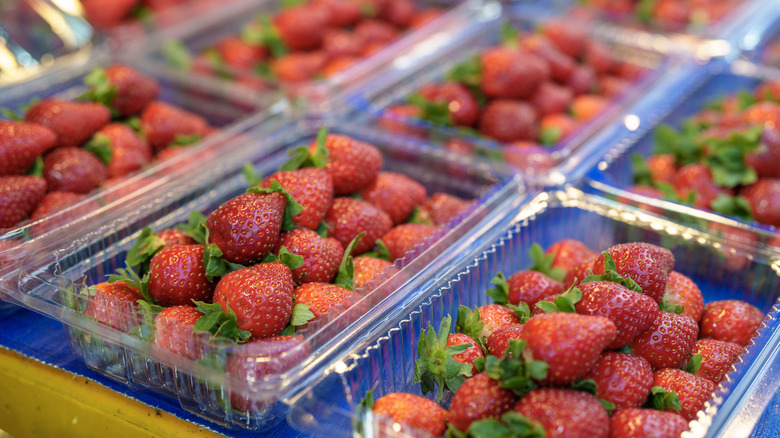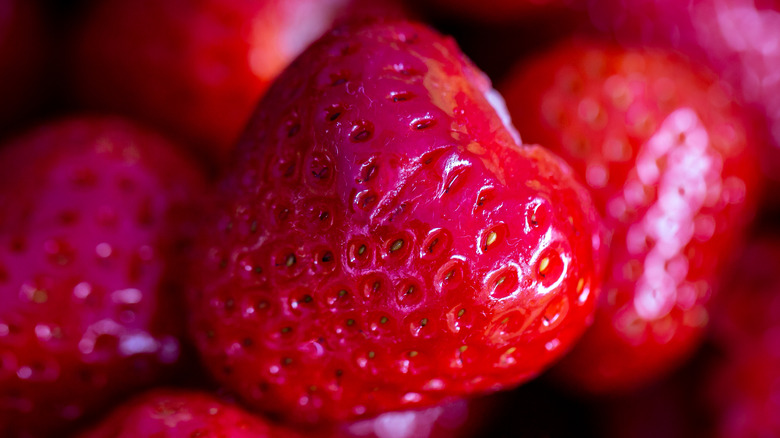13 Storage Tips For Longer-Lasting Strawberries
Nothing is more frustrating than bringing a batch of ripe, red strawberries home from the market, only to check on them the next day and realize half of them are rotten. They're so expensive that it always feels like a crime against the universe (or perhaps against you, perpetrated by the universe?) when they go bad. That's especially true when you had a dinner party coming up, were planning on making some chocolate-covered strawberries or fun Italian cocktails for Valentine's Day, or had big Juneteenth strawberry soda plans in the offing.
The good news is that losing a healthy percentage of your strawberries is not a given. By taking proper precautions when you bring your berries home, you can keep them for up to a week without any spoilage. So, how can you store them for best results? That's where this guide comes in.
Note that many of the suggestions below have the word "try" in the title. That is because your preferred method is subject to too many factors to know what will work best. Depending on where you got the berries and how old they were then, how hot your kitchen is, how cold your fridge is, and how quickly you'll eat your berries, these methods will produce varying results. The important thing is to give each of these your best shot to find what works.
Pick out spoiled berries
First and foremost, you want to remove spoiled berries as soon as you bring them home. Yes, it's an extra hassle because it means separating your berries and picking out anything that looks mushy, brown, or fuzzy. However, it's also one of the best and easiest strawberry hacks to help ensure your expensive goods remain, well, good for as long as possible. Although it's annoying, this is the best way to protect the rest of your berries.
If you don't take this step, then the mold (and potentially bacteria) that made them rotten can spread from one berry to another, possibly ruining your whole batch. Mold is tricky to fight because it can grow on almost any surface that contains moisture and organic matter, which certainly includes strawberries. It spreads through tiny spores invisible to the naked eye and can quickly pass from one berry to another. Never assume, therefore, that you can get the bad ones later, and it will be fine. The same is true of bacteria.
When removing moldy strawberries, make sure to wash your hands after you touch a spoiled one. One of the fastest ways to spread contamination is by using the same utensil (in this case, your fingers) without washing it. Avoid that and your other berries will last longer.
Never wash mold off
Washing off mold is unlikely to work effectively, as mold can spread beneath the surface of the fruit. Plus, water itself can speed up spoilage. Washing is unlikely to truly remove the problem, and may instead just make it easier for mold or bacteria to spread to another berry.
Instead, you can cut moldy parts off if the fruit is firm. Just make sure to cut around the moldy area at least an inch down so you can be assured of removing it all. Given the size of your average strawberry, that probably means this method won't work, but it's good to have in your back pocket for other types of fruit. In that case, you should also cut rather than wash so as not to simply rub the mold onto a greater surface area.
Even if you have a huge strawberry and could cut around the mold, rethink this if the berry is mushy. In that case, it's probably best to let the fruit go entirely. Don't worry about firm strawberries that were next to moldy ones, though. If they seem okay, they probably are, and you don't need to throw them away.
Store berries in the fridge
Unless you're planning on serving berries that day or the next, you should put them in the fridge. If you're going to store them on the counter, make sure the berries have good airflow from a mesh basket or other loose storage device. Room-temp storage can be preferable for fruit that's going onto a platter or will otherwise be eaten on its own, as refrigeration changes the flavor of berries by limiting the sweet smell on which our palate relies to signal that signature strawberry taste. In essence, refrigerated berries just aren't as yummy. Always leave stems on when storing berries on the counter.
If you're not eating right away, put berries in the fridge. There, they will last 3-7 days, depending on how fresh they were when you got them and whether you've successfully removed moldy berries. Just make sure to check on them during that time, or you might lose the batch.
Don't wash until you're going to use
Remember that washing berries can speed up the spoilage process, spreading mold and bacteria. It also adds moisture and makes them mushy, reducing their overall freshness. As a general rule, whether you're storing berries on the counter or in the fridge, try to avoid washing them. Do it right before you're going to serve them instead. If you're only using a few at a time, only wash as many as you're going to eat right then. (There are some exceptions to this rule, as we will discuss in "Try the vinegar method.")
When you do wash berries, rinse them well, until any dirt or debris from the field (like straw) comes off. Do not use soap, as the berries may absorb it. This can change the flavor of your fruit, which certainly isn't ideal for the enjoyment factor. Also, although you're unlikely to ingest soap in high enough quantity to do any damage, you should know that soap can make you quite sick.
Never store strawberries wet
Sometimes you feel you must wash berries. This might be true when you're prepping for a party the next day, say, or have to grab a snack for the carpool as soon as you get home from work on the morrow. If you have to prep berries ahead of time (specific suggestions to follow), go ahead and wash them ... but like a horse, you must never put them away wet.
The good news is, if you carefully dry your berries, they will weigh the same amount as they did before washing, which indicates they haven't picked up any moisture. The best bet is to wash then spin strawberries in a paper towel-lined salad spinner. Simply line it with paper towels or rags, which is the more environmentally friendly choice, then line the spinner with berries. Ideally, you want them in a single layer. Spin as you would lettuce, et voilà, spoilage-proof strawberries that are good for later.
Provide airflow
Airflow is a key ingredient in keeping strawberries fresh. As discussed, since bacteria and mold need moisture to thrive, airlfow minimizes environments in which they can grow. This is the same reason master gardeners advise homeowners to prune their shrubs and trees until you can see light passing through the branches; airflow makes it harder for moisture to collect and pathogens to take root.
As such, you should avoid storing strawberries in airtight containers. Rather, leave them in the loosely woven plastic baskets or the hole-filled clamshell pints and quarts they came in. If they came from the farmer's market, go ahead and put them back in their paper quarts after you've picked them over for mold.
People are torn on airflow, though. Some maintain that a tight seal is the long-lasting strawberry's best friend because it reduces airflow and, since mold needs oxygen to grow, that will inhibit spread. You'll have to experiment to be sure. If you want a seal, you might keep them suspended in the salad spinner. Others suggest canning jars lined with paper towels.
Try the paper towel method
Strawberries are popular indeed, produced in countries across the world, and have made it into some of the most beloved dishes and desserts globally. Think strawberry Charlotte, Neapolitan ice cream, and even soda pop. First mentioned in writing around 200 B.C.E. or so, this not-so-humble berry has only grown in popularity since then. What isn't nearly as global as our love of the strawberry? If you guessed "the paper towel method," good on you.
Yet this trick is everything. Using paper towels not only removes moisture that may have come on the surface of the strawberries (from a grocery store mister, for instance), but also wicks it away when it builds up in the fridge. Lining containers with paper towels can help berries last longer, so after you sort and treat your berries, line the cartons in which they came with paper towels to keep moisture levels down. You can use this trick on the counter or in the fridge. It may work with rags, too, since you can safely dry strawberries on a towel, but the rags will have to be thin to fit in the containers.
Try the vinegar method
If strawberries and vinegar don't sound like a match made in heaven, you're not alone. It reminds one of the disastrous dinner party in "Little Women," in which Jo serves berries and cream using spoiled dairy and salt rather than sugar. But trust that this is a much better idea than letting an unschooled teenager into the kitchen; promise.
Here's the thing: By the time berries get to you, they can be pretty old. Indeed, given proper cold storage techniques, berries can last weeks or months before they even get to the grocery store, meaning that while they might not be spoiled, they're not as fresh as you'd hope. They've had a potentially long stretch of time to slowly develop mold and bacteria, much of which might not even be visible to the naked eye yet. Therefore, when berries come out of cold storage and get exposed to moisture and airflow, any bacteria or mold spores present may start to reproduce.
Supposedly, washing the strawberries in a mixture of vinegar and water when you get them can reduce the chances of spoilage because the acetic acid in vinegar has antimicrobial properties. For that reason, some bloggers swear by this trick. To use it yourself, combine water and white vinegar in a 3:1 ratio, then let strawberries soak for a few minutes. Afterward, remove the berries and dry them as you normally would after washing before putting them back in a storage container that maximizes airflow.
Try the hot water method
Not into vinegar, or simply don't have it lying around at the moment, but want to wash ahead? No worries, you can try hot water, which is also known for its cleansing properties. While the hot water that comes from the tap is not a high enough temperature to kill bacteria, it can remove oils that harbor it, which is why handwashing is an effective method to avoid spreading illness. That said, who would have thought you could apply the hot water technique to delicate berries, which are always best stored at room temperature or chilled?
Still, the thinking goes, berries aren't that fragile. They must, after all, withstand high temperatures in the field, growing in the hottest months of the entire year. Therefore, a short exposure to heat can help clean them without doing much damage. Basically, the idea is that hot water at 125 degrees Fahrenheit does a better job of suppressing mold growth than cold water but isn't hot enough to harm the berries. Dunk them or hold them under running water for 30 seconds for best results, which should make them last a week before molding, according to enthusiasts.
Just know that this approach has super-de-duper mixed reviews on the ol' interwebz. Other sources found that hot water didn't prevent nearly as much spoilage and that 60% of berries were unusable after a week. Feel free to give this technique the old college try, or simply skip washing ahead.
Beware of berries at the bottom
One of the biggest red flags when buying produce is squished berries, yet many of us don't even check the state of the strawberries at the bottom of the basket. Granted, it can be kind of hard to peer through the holes of an opaque or paper container, but it's worth doing a little investigation to see if there's any mush going on. If the berries come in clear plastic, always check the bottom by lifting up the container.
Even if they look fine at the store, berries at the bottom of a strawberry container (especially a large quart-sized container with heavier fruits) are likely to get squished after a week or two in said container. One of the most important steps to take is to give those bottom berries some relief. After picking them over, you can try to extend their shelf life by laying them out as flat as possible.
Ideally, you will then store your strawberries in a single layer in the fridge. Some sources recommend using a sheet pan lined with paper towels (again, thin rags will likely work here). Sheet pans are space hogs, of course, so it all depends on how much room you have to offer. For those who have more than one fridge on the property, this is a no-brainer.
Try storing berries upside down
TikTok to the rescue! A TikTok hack claims that when you bring your berry clamshells home from the store, you should open the lid, line it with a paper towel, close it, and then flip it upside down. Storing it in the fridge like so will help prevent rot while giving the berries on the bottom a break from the pressure.
This is a different take on the paper towel method. Essentially, the genius behind this idea is that by the time your berries get to you, they've been sitting in that carton for a while. As such, those bottom berries have been feeling the weight of the berries above and could really use a break ... but you don't have to do the whole single-layer-sheet-pan thing if you don't want to. In order to provide said relief, all you have to do is open the carton, line the top with a paper towel, close it, and flip. Afterward, store them in the fridge upside down to preserve those bottom berries.
Ideally, you will pick through your berries (and avoid getting them wet), as we've already discussed. However, if you simply don't have time, you can just stick the towel in there, flip it, and stow it in the fridge until you do. Just make sure to pick through your berries within a day or two since spoilage can spread from one to another quickly, no matter how much flipping you do.
Store in a jar and use the salt method when hulling berries
The best way to keep strawberries fresh is to avoid hulling them. Removing the cap exposes the inside of the strawberry to air and moisture, which can speed up spoilage. If you don't have to hull them, don't. Really need to hull strawberries for some reason? There's a prep method for that.
First, you'll want to wash your strawberries. You can use the hot water or vinegar method if either of those works for you, or you can treat your strawberries with a kosher salt bath, using 2 tablespoons per large bowl of water. Soak strawberries for 5 minutes before hulling and thoroughly drying them. Then keep them in an airtight container. If they were fresh, then this method may keep them fresh for up to a week.
Strawberry purée will also go bad faster than whole strawberries. If you need to make it for an upcoming dessert, or you had berries going off and wanted to preserve them, you might choose to purée them. Just make sure to use it up in 3-5 days, as it won't last a full week like whole berries do. However, purée freezes great, so feel free to pop it in the freezer for up to three months.
Match your storage time to your prep method
How long berries last depends on factors beyond your control, such as when they were picked and how long the grocery store has had them. One of the factors within your control, however, is the storage mechanism you choose. Always correctly match storage time to prep method, from purée to hulled berries to whole specimens to frozen fruit.
Whole fruit that hasn't been picked over can spoil at any time. When it has been picked over, you can expect 1-2 days of shelf life on the countertop and up to a week in the refrigerator. Supposedly, treating with the vinegar, hot water, and salt methods can make berries last up to a week and sometimes longer in the fridge, though you will need to experiment on your own. Untreated and unwashed berries may last that long in the fridge, as they are surprisingly resilient when you remove moldy specimens.
If you're going to prep further, you will either shorten or extend shelf life. Hulling may or may not reduce storage time (around a week, depending on freshness), while puréeing definitely will (3-5 days). Frozen berries can last up to three months sliced or whole, though note that they become mushy when thawed. As such, you can't expect to serve them in their defrosted state. But frozen berries are great in smoothies (still frozen) or cooked into pies and jams (thawed). The takeaway: Consider intended use before prepping berries.
